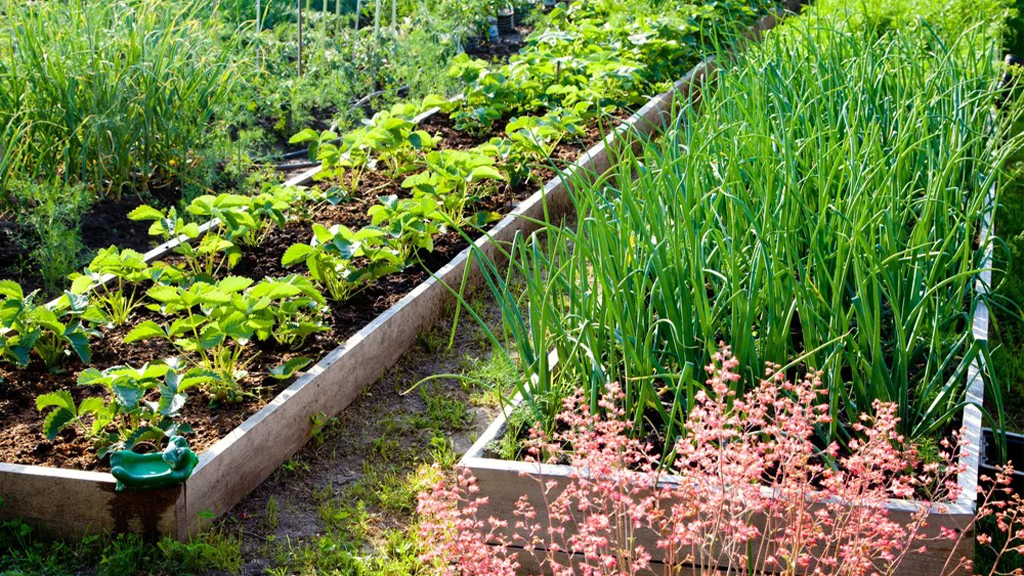A vegetable garden can be both functional and beautiful. It not only provides fresh food for your family, but also can be an eye-catching addition to your garden. With a little creativity and planning, you can transform your vegetable garden into a stylish and inviting space. In this article, we discuss ways to design your vegetable garden and make it a stunning focal point of your garden.
Choose a theme
Choosing a theme is a great way to give your garden a cohesive and stylish look. Popular themes include a rustic farm garden, cottage garden, or modern garden. Once you’ve chosen a theme, you can choose plants, containers, and decorations that go with that theme.
For example, a rustic, farmhouse-style garden might include wooden crates for container planting, old milk cans or watering cans for decoration, and old vegetables. A cottage garden might include a mix of flowers and vegetables, a picket fence, and vintage gardening tools. A modern garden might feature geometric shapes, clean lines and a monochromatic color scheme.

Integrate containers
Container gardening is a great way to add visual interest to your vegetable garden. Not only do containers allow you to grow plants in areas where there is no soil, but they also add height and structure to your garden. Consider using a mix of different types of containers, e.g. B. pots, planters and wooden boxes. You can also use unusual objects such as old wheelbarrows or metal buckets as containers.
When choosing containers, consider the size of the plants you plan to grow. Some vegetables, like tomatoes and cucumbers, require large containers, while others, like lettuce and herbs, can be grown in smaller pots. Make sure you choose containers that are appropriate for the plants you plan to grow.
Add decorative elements
Decorative elements can take your vegetable garden from functional to fabulous. Consider adding items like garden statues, bird feeders, wind chimes, or even a small water feature. Not only do these elements add visual interest to your yard, but they can also attract beneficial wildlife like birds and butterflies.
When choosing decorative elements, make sure you select items that match your theme and the size of your garden. Large statues or water features can overwhelm a small garden, while small items can get lost in a larger space.
Use vertical gardening techniques
Vertical gardening is a great way to maximize your grow space and add height to your garden. You can use trellises, stakes, or even a garden arch to support climbing plants like tomatoes, cucumbers, and beans. This not only makes harvesting easier, but also creates a beautiful vertical garden.
In addition to supporting plants, you can also create a living wall by using a pallet or trellis to support plants like lettuce or herbs. This is a great way to add a touch of greenery to a small space or urban garden.

Mix vegetables and flowers
Mixing vegetables and flowers is a great way to create a colorful and vibrant garden. Flowers not only add visual appeal to your garden, but they can also attract beneficial insects and pollinators. Consider planting marigolds, zinnias, or sunflowers among your vegetables.
When choosing flowers, be sure to choose varieties that suit the growing conditions of your vegetable garden. Some flowers, such as marigolds, can help repel pests, while others, such as sunflowers, can provide shade and support for your veggies.
Create a path
Creating a path in your vegetable garden not only adds a stylish element, but also makes it easier to navigate and maintain. You can use different materials for your path, for example stones, gravel or wood chips.
Add lighting
Outdoor lighting can enhance the atmosphere of your vegetable garden and allow you to enjoy it even in the evening hours. Consider installing solar powered lights along your path or around your bins. You can also use fairy lights or lanterns to add a warm and welcoming glow to your garden.
Create raised beds
Raised beds not only look stylish, but also offer numerous advantages for your vegetable garden. They allow you to control the quality of your soil, improve drainage and make it easier to maintain your garden. You can use different materials for your raised beds, for example wood, metal or stone.
When designing your raised beds, consider the layout of your garden and the size of the plants you plan to grow. You can create raised beds in different shapes and sizes, such as rectangular, square or circular.

Incorporate edible flowers
Edible flowers not only add a pop of color to your vegetable garden, but they also provide an additional source of fresh produce. Popular edible flowers include nasturtium, marigold, and borage. These flowers can be added to salads or used as a side dish.
When planting edible flowers, be sure to choose varieties that are safe to eat and appropriate for your growing conditions. You can also use flowers as a natural pest repellent. For example, marigolds can help repel pests like aphids and whiteflies.
Use companion planting
In community planting, different plants are planted together that in some way benefit each other. For example, planting basil near tomatoes can repel pests and improve the flavor of the tomatoes. Planting marigolds near beans can help repel pests and improve bean growth.
For companion planting, be sure to choose plants that provide complementary growing conditions and benefit from each other. This can help you create a healthy and thriving vegetable garden.
In summary, landscaping your vegetable garden is a great way to create a beautiful and functional outdoor space. By incorporating containers, decorative elements, vertical gardening, mixing vegetables and flowers, creating a path, adding lighting, using raised beds, including edible flowers, and using companion plants, you can transform your vegetable garden into a stylish and inviting oasis. With a little creativity and planning, you can enjoy bountiful harvests and a stunning garden all season long.


